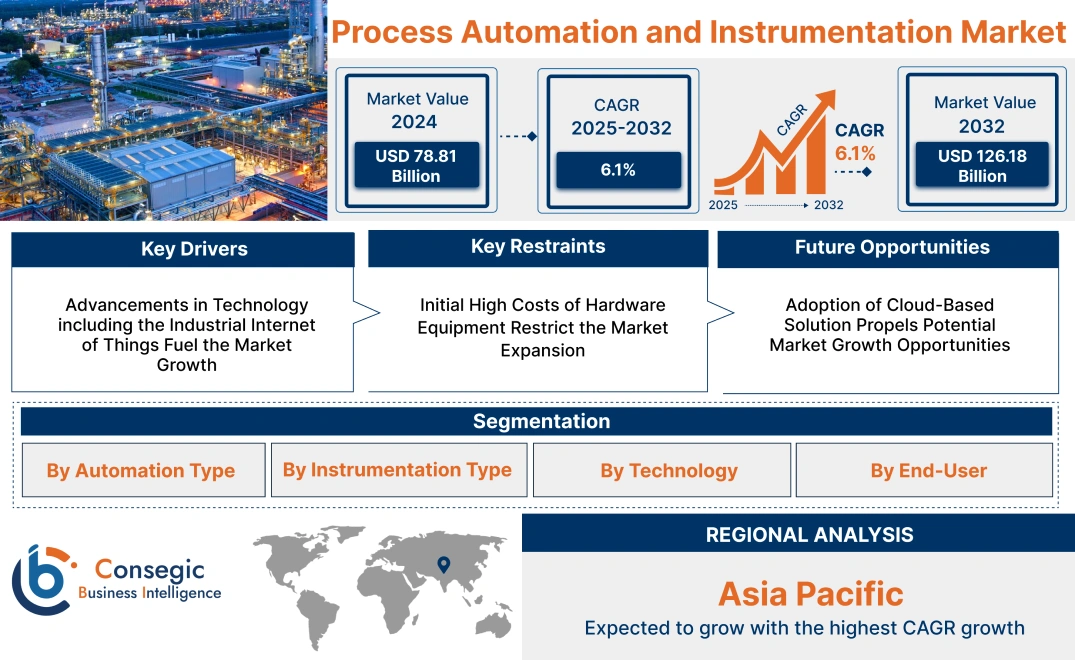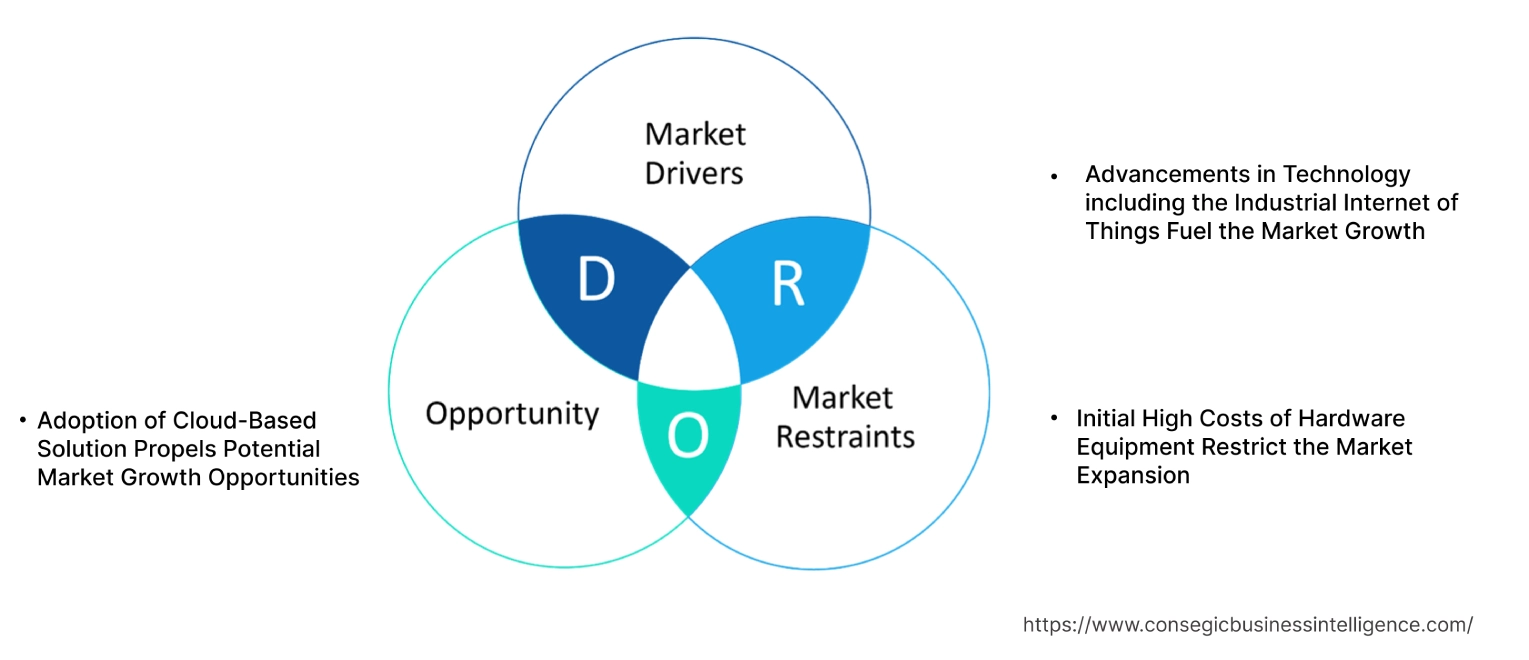Process Automation and Instrumentation Market Size:
Process Automation and Instrumentation Market size is estimated to reach over USD 126.18 Billion by 2032 from a value of USD 78.81 Billion in 2024 and is projected to grow by USD 82.18 Billion in 2025, growing at a CAGR of 6.10% from 2025 to 2032.
Process Automation and Instrumentation Market Scope & Overview:
Process Automation and Instrumentation refers to a field that focuses on automating and controlling industrial processes using various technologies and instruments. It is pivotal in ensuring efficiency, safety, and consistency across manufacturing and other industrial operations. Process automation leverages technology to automatically manage industrial processes without the need for human intervention. This encompasses controlling machinery, monitoring production lines, and ensuring smooth and efficient operation. Instrumentation, on the other hand, involves the use of devices and instruments to measure, monitor, and control physical quantities including temperature, pressure, flow, and level within industrial processes. The aforementioned features of process automation and instrumentation are major determinants for increasing their deployment in automotive, pharmaceutical, oil and gas, and other industries.
Process Automation and Instrumentation Market Insights:
Process Automation and Instrumentation Market Dynamics - (DRO) :
Key Drivers:
Advancements in Technology including the Industrial Internet of Things Fuel the Market Growth
The Industrial Internet of Things (IIoT) constitutes a comprehensive ecosystem, encompassing devices, sensors, applications, and related networking infrastructure. These collaborate to gather, oversee, and scrutinize data derived from industrial processes. The analysis of this data significantly augments visibility, thereby enhancing the capabilities for troubleshooting and maintenance. Additionally, integration with Artificial Intelligence (AI) is transforming traditional automation by enabling predictive maintenance, advanced analytics, and real-time decision-making. These technologies enhance the capabilities of industrial automation systems, making them more efficient and reliable.
- In July 2023, ABB and Microsoft collaborated to launch the ABB Ability Genix Industrial Analytics and AI Suite with Microsoft Azure OpenAI Service. It combines data analytics and AI to automate and optimize industrial operations. The suite aims to boost operational efficiency reduce operational costs by up to 20% and reduce downtime by 60%, supporting global competitiveness.
Therefore, rising technological advancements in IIoT and artificial intelligence in Industrial automation are propelling the global process automation and instrumentation market growth.
Key Restraints :
Initial High Costs of Hardware Equipment Restrict the Market Expansion
Initial high costs encompass the expense of acquiring advanced equipment, software licenses, and the integration of new systems with existing infrastructure. For many companies, especially small and medium-sized enterprises (SMEs), this upfront expenditure is substantial and exerts strain on financial resources. Additionally, training personnel to operate and maintain new systems adds to the overall cost, making it challenging for SMEs to justify the investment without clear, immediate returns.
- For instance, Siemens' Digital Enterprise Suite can cost between USD 750,000 and USD 3 million, depending on the scope. Rockwell Automation's FactoryTalk Innovation Suite ranges from USD 600,000 to USD 2.5 million, while Honeywell's Experion PKS Edge typically falls between USD 1 million and USD 4 million.
Hence, the high initial cost of hardware equipment is hindering the process automation and instrumentation market demand.
Future Opportunities :
Adoption of Cloud-Based Solution Propels Potential Market Growth Opportunities
Cloud-based automation solutions are gaining traction due to their scalability, flexibility, and cost-effectiveness. These solutions allow companies to access and manage automation systems remotely, facilitate collaboration across locations, and reduce the need for on-premises infrastructure. The growth of cloud technology presents chances for developing new automation services and enhancing existing ones. Additionally, it is equipped with advanced analytics capabilities that enable companies to derive real-time actionable insights from their automation data. By leveraging cloud-based data storage and processing power, businesses can analyze large volumes of data to identify trends, optimize processes, and make data-driven decisions.
- In December 2023, ABB launched ABB Ability Field Information Manager 3.0 designed to enhance industrial automation through cloud-based data management and analytics. The platform provides remote access to process data, enabling real-time insights and control.
Process Automation and Instrumentation Market Segmental Analysis :
By Automation Type:
Based on automation type, the market is segmented into Industrial Automation, Process Automation, Robotic Process Automation, Building Automation, and Others.
Trends in the automation type:
- The trend towards smart buildings is growing, with advancements in IoT and cloud computing enabling more sophisticated building management systems. Smart buildings use interconnected sensors and devices to manage HVAC, lighting, and security systems more efficiently, enhancing comfort and reducing energy consumption.
The industrial automation segment accounted for the largest revenue share of 31.67% in 2024.
- Industrial automation focuses on automating manufacturing processes to improve efficiency, precision, and safety.
- Industries including automotive, electronics, and consumer goods are increasingly adopting automation technologies to boost production capabilities and reduce operational costs.
- In November 2021, Siemens launched several Ecosystems, an IT platform that enables scalable deployment. These devices allow industrial automation to perform advanced data processing and analytics.
- Consequently, rising demand for industrial automation for improved production and real-time monitoring is driving the process automation and instrumentation market share.
The process automation segment is anticipated to register the fastest CAGR during the forecast period
- Process automation is a process to automate complex business processes.
- It is designed to remove bottlenecks and reduce errors and loss of data, all while increasing transparency, communication across departments, and speed of processing.
- Additionally, process automation is central to Industry 4.0, providing the tools and technologies necessary for achieving interconnected and intelligent production systems.
- In November 2022, Yokogawa introduced CENTUM VP R6.10 distributed control system, featuring enhanced functionality and integration with cloud-based services. The CENTUM VP offers improved process control, data analytics, and operational flexibility, supporting process automation in various sectors supporting Industry 4.0.
- Thus, the ability of process automation to automate complex business processes is boosting the global process automation and instrumentation industry.
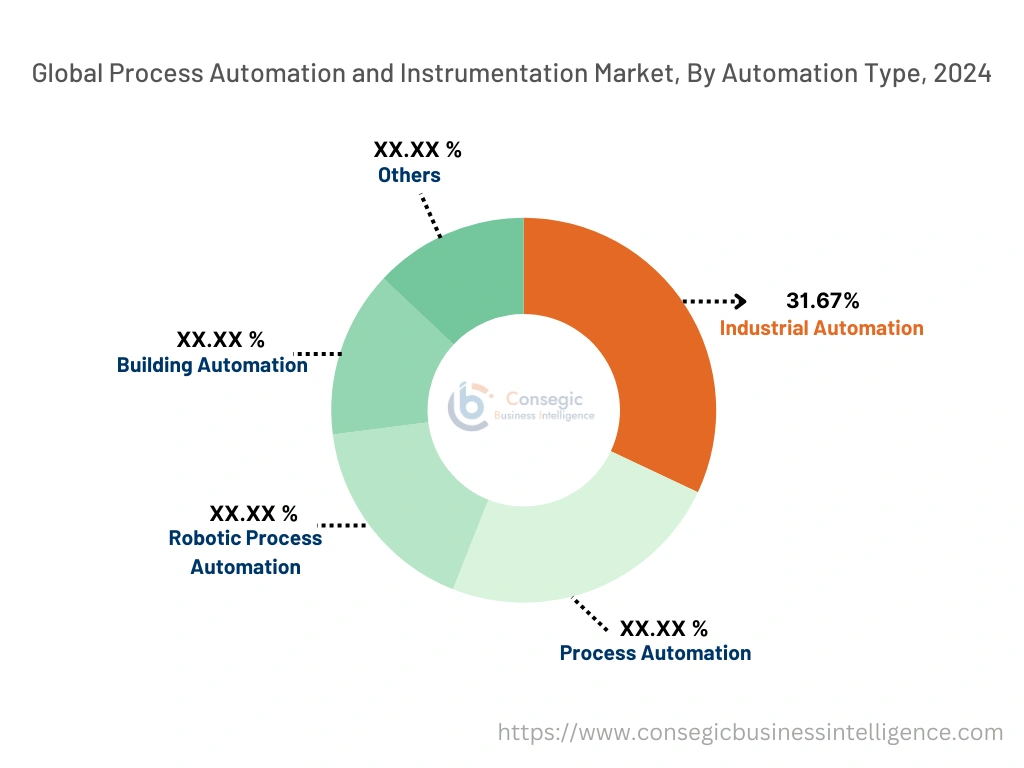
By Instrumentation Type :
Based on instrumentation type the market is segmented into measurement instruments, control instruments, analytical instruments, flow instruments, level instruments, signal instruments, and others.
Trends in the Instrumentation Type:
- Control instruments are being integrated with sophisticated control systems, including distributed control systems (DCS) and programmable logic controllers (PLCs). This integration enables better coordination and management of complex processes across different operational areas.
- An emerging trend is the development of portable and on-site analytical instruments that provide real-time analysis and immediate results. These instruments are especially useful in field applications, as well as in environments where laboratory study is impractical.
The measurement instrument segment accounted for the largest revenue share in the year 2024.
- Measurement instruments are essential for accurate data collection and process control across various industries.
- It provides precise measurements of parameters including temperature, pressure, flow, and level, enabling effective process monitoring and optimization.
- In April 2021, Siemens introduced the Sitrans MS200 IIoT Sensors. These instruments collect data on temperature, pressure, and flow in factory equipment and transmit it to cloud platforms for predictive analytics. This allows manufacturing companies to use real-time data to optimize operations and improve maintenance strategies, significantly reducing downtime.
- Therefore, measurement instrument provides accurate data collection and precise measurements of various parameters, driving the process control and instrumentation market growth.
The analytical instrument segment is anticipated to register the fastest CAGR during the forecast period.
- An analytical instrument is a device that qualitatively and quantitatively measures the composition, status, and properties of substances.
- These instruments are increasingly being integrated with data analytics platforms and digital technologies.
- Additionally, this integration enables advanced data analysis, enhances decision-making, and provides deeper insights into complex processes.
- For instance, Bruker's S2 PUMA Series 2 Energy-Dispersive X-ray Fluorescence (XRF) Spectrometer, provides high-throughput and accurate elemental analysis for industrial and research applications. The S2 PUMA is designed for reliable and fast analysis of various materials, including metals, minerals, and environmental samples.
- Hence, the ability of analytical instruments to provide advanced data analysis and insights for informed decision-making is boosting process automation and instrumentation market demand.
By Technology:
Based on technology, the market is segmented into Programmable Logic Controllers (PLCs), Distributed Control Systems (DCS), Supervisory Control and Data Acquisition (SCADA), Human Machine Interface (HMI), and Others.
Trends in the technology:
- Digitalization is taking over DCS technologies with digital twins, cloud-based control systems, and advanced analytics. Enhanced automation will become more accurate in industrial processes due to this trend.
- Mobile and wireless SCADA solutions are becoming a necessity as they provide greater flexibility and accessibility. Therefore, it allows operators to monitor and control industrial processes from anywhere through mobile SCADA applications.
The PLC technology segment accounted for the largest revenue share in the year 2024.
- PLCs are fundamental to industrial automation as they provide the ability to control machinery and processes across a wide range of industries.
- These instruments are preferred for their robustness, real-time processing capabilities, and flexibility to integrate with advanced technologies including IoT and edge computing.
- In April 2023, Siemens' Simatic S7-1500V control instruments widen the current Simatic range and fulfill specific market needs like hosting PLC computing virtually. This is an expanding portfolio designed for production engineering, execution, and optimization, which Siemens is integrating into its offerings on Siemens Xcelerator, the digital business platform. Siemens is continuously combining IT and software capabilities with its Industrial Operations X.
- Therefore, due to its versatility, reliability, and enhanced control over machinery, the PLC segment is proliferating the process automation and instrumentation market growth.
The HMI technology segment is anticipated to register the fastest CAGR during the forecast period.
- HMI is a technology that enables the interaction of operators with the machines.
- The technology includes tactile, acoustic, bionic, and optical, which enhances user experience by providing touch-sense, voice control, and haptic feedback.
- Additionally, advancements in voice recognition, natural language processing (NLP), multi-modal interaction, and sound-based feedback are the reason for adoption.
- In January 2022, Google launched Nest Hub 2nd Gen, which features a voice-first interface that leverages advanced acoustic HMI technology. With improved voice recognition and NLP capabilities, the device offers seamless voice control for automation processes and other tasks.
- Hence, the haptic feedback technology of HMI is driving the process automation and instrumentation market opportunities.
By End-User:
Based on end-user industries, the market is segmented into automotive, oil and gas, pharmaceutical, food and beverages, energy and utilities, aerospace, healthcare, and others.
Trends in the end-user :
- Cutting-edge manufacturing techniques including modular production and continuous manufacturing are being approved by the pharmaceutical industries. By relying on automation, these methods help in increasing flexibility, lowering production costs as well as speeding up the introduction of new drugs into the market.
- The food and beverage sector has implemented intelligent packaging systems that rely on automation to give live information about how fresh- the products are, their expiration period, as well as how much stocks remain for each item. Consequently, it improves supply chain management and customer satisfaction as well.
The automotive end-user segment accounted for the largest revenue share in 2024 and is anticipated to register the fastest CAGR during the forecast period.
- The automotive sector is increasingly integrating advanced instruments into automobiles to streamline manufacturing processes.
- These sensor instruments are used in collision avoidance, lane-keeping, and adaptive cruise control and are driving the market in this segment.
- Additionally, there is a significant demand for sensors in automotive safety features including Advanced Driver Assistance Systems (ADAS).
- In September 2022, Continental launched Modular multi-sensors that integrate advanced technologies for commercial vehicle safety and automation. This includes sensors for detecting environmental conditions and vehicle status, which are essential for implementing and improving safety features and autonomous driving capabilities.
- Consequently, the sensor instruments provide automotive safety features in the sector is propelling the process automation and instrumentation market.
Regional Analysis:
The regions covered are North America, Europe, Asia Pacific, the Middle East and Africa, and Latin America.
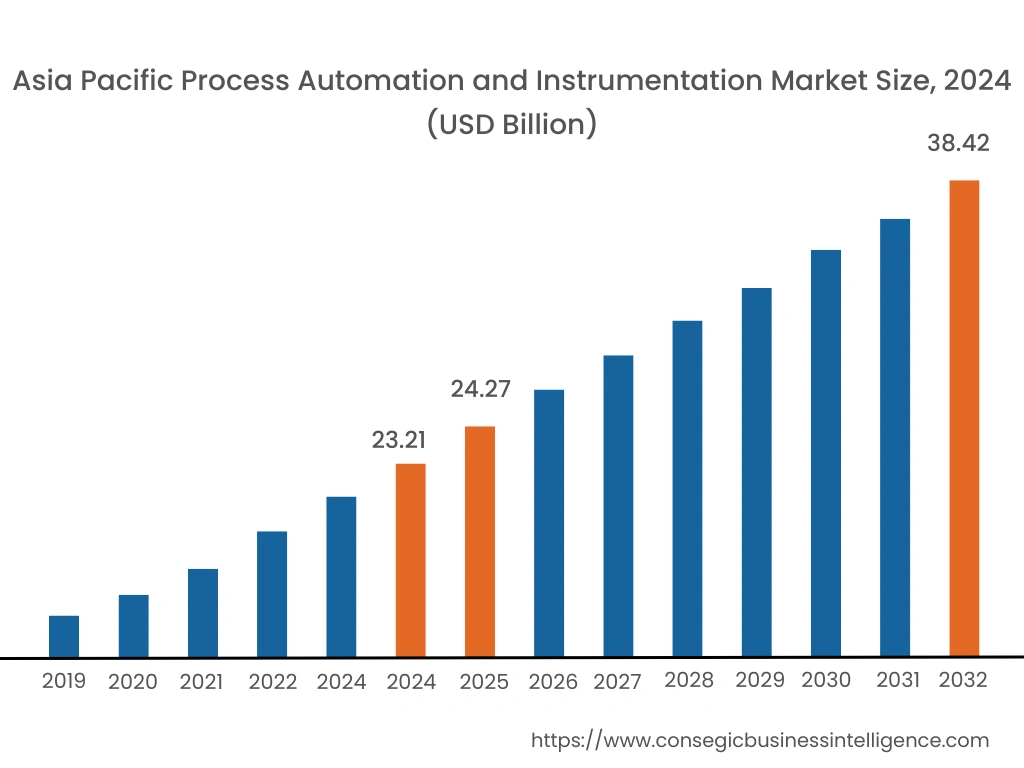
Asia Pacific region was valued at USD 23.21 Billion in 2024. Moreover, it is projected to grow by USD 24.27 Billion in 2025 and reach over USD 38.42 Billion by 2032. Out of this, China accounted for the maximum revenue share of 31.3%. As per the process automation and instrumentation market analysis, the Asia-Pacific region including China, Japan, India, and South Korea is experiencing rapid industrial growth, which is boosting the demand for process automation and instrumentation. Additionally, technological advancement including artificial intelligence, industrial internet of things, and cloud computing in the industrial automation process is fueling the process automation and instrumentation market opportunities.
- In April 2024, Yokogawa (Japan) launched an upgraded version of its CENTUM VP distributed control system featuring AI-driven process optimization. This new functionality allows for real-time adjustments and predictive maintenance based on advanced data analytics.
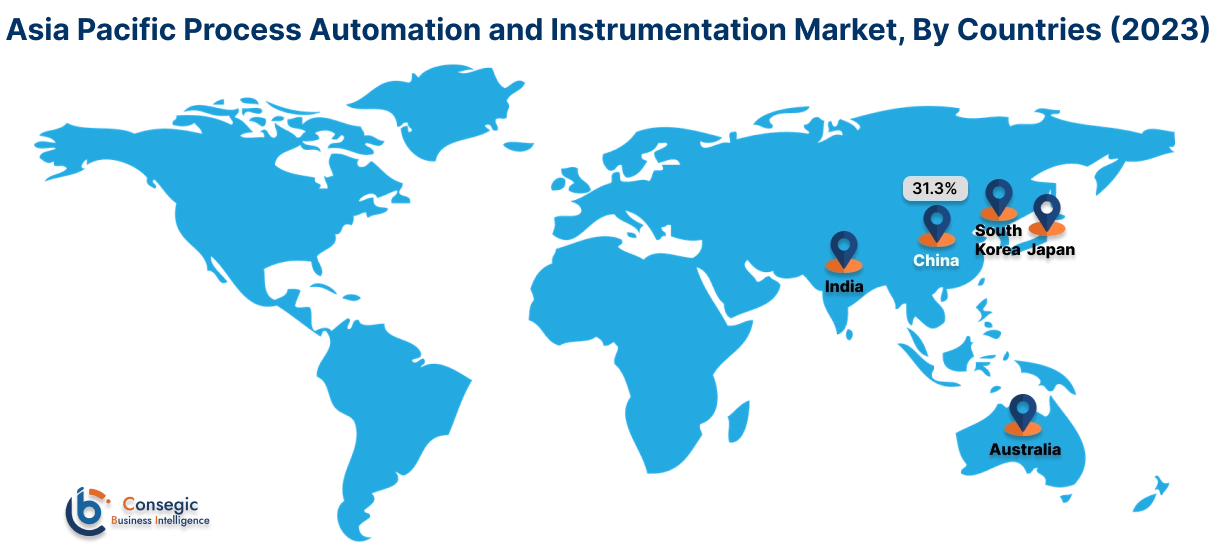
North America is estimated to reach over USD 40.89 Billion by 2032 from a value of USD 26.14 Billion in 2024 and is projected to grow by USD 27.21 Billion in 2025. North America region, particularly the United States and Canada, is a leader in adopting advanced manufacturing technologies including process automation and instrumentation.
- In November 2022, Emerson (US) expanded Rosemount 3051 Pressure Transmitter with Bluetooth wireless technology, for pressure and temperature measurement. The wireless sensor instrument supports automation systems, enabling real-time data transmission and enhancing operational efficiency without physical contact.
Europe is at the forefront of Industry 4.0, with widespread adoption of smart manufacturing and process automation technologies. The integration of robotics, AI, and advanced sensor instruments into production processes in transforming industries.
Latin America is witnessing significant industrialization, particularly in countries including Brazil, Mexico, and Argentina. This industrial expansion is driving the adoption of process automation and instrumentation solutions across various sectors.
The Middle East particularly countries including Saudi Arabia and the United Arab Emirates (UAE) continue to major the process automation and instrumentation market fueled by the oil and gas sector.
Top Key Players & Market Share Insights:
The process automation and instrumentation market is highly competitive with major players providing industrial automation to the national and international markets. Key players are adopting several strategies in research and development (R&D), product innovation, and end-user launches to hold a strong position in the process automation and instrumentation market. Key players in the process automation and instrumentation market include-
- Honeywell International Inc. (US)
- Rockwell Automation (US)
- Yokogawa Electric Corporation (Japan)
- General Electric (GE) Digital (US)
- Emerson (US)
- Cisco Systems (US)
- Net Company (United Kingdom)
- IBM Corporation (US)
- Toshiba (Japan)
- Eaton (US)
- Itron (US)
- Siemens AG (Germany)
- S&C Electric Company (US)
- Landis+Gyr (Switzerland)
Recent Industry Developments :
Product Launch:
- In June 2024, IBM introduced IBM Maximo Application Suite 9.0, introducing advanced features aimed at enhancing automation in enterprise asset management. It incorporates AI-driven predictive maintenance capabilities allowing organizations to monitor data and perform predictive analytics.
- In February 2024, Honeywell introduced the Experion PKS R530, a next-generation process automation system designed to enhance control and monitoring in industrial environments. The system features advanced analytics, real-time data visualization, and integration with cloud-based services, providing improved efficiency and operational insights.
- In February 2024, Schneider Electric unveiled the EcoStruxure Control Expert, an advanced software solution for industrial automation that integrates with their EcoStruxure platform. The software provides enhanced programming capabilities, real-time diagnostics, and seamless integration with IoT devices. Schneider Electric's press release emphasized the software's impact on improving manufacturing efficiency and enabling smarter process control.
- In October 2023, Rockwell Automation, Inc. introduced the FactoryTalk Optix portfolio to help industrial companies create flexible human-machine interface (HMI) solutions that satisfy a variety of customer needs and adjust to changing technologies. The FactoryTalk Optix collection consists of Rockwell Automation's HMI platform and remote access software, along with Embedded Edge Compute Modules and various deployment choices.
Process Automation and Instrumentation Market Report Insights :
| Report Attributes | Report Details |
| Study Timeline | 2019-2032 |
| Market Size in 2032 | USD 126.18 Billion |
| CAGR (2025-2032) | 6.1% |
| By Automation Type |
|
| By Instrumentation Type |
|
| By Technology |
|
| By End-User |
|
| By Region |
|
| Key Players |
|
| North America | U.S. Canada Mexico |
| Europe | U.K. Germany France Spain Italy Russia Benelux Rest of Europe |
| APAC | China South Korea Japan India Australia ASEAN Rest of Asia-Pacific |
| Middle East and Africa | GCC Turkey South Africa Rest of MEA |
| LATAM | Brazil Argentina Chile Rest of LATAM |
| Report Coverage |
|
Key Questions Answered in the Report
How big is the Process Automation and Instrumentation Market? +
Process Automation and Instrumentation Market size is estimated to reach over USD 126.18 Billion by 2032 from a value of USD 78.81 Billion in 2024 and is projected to grow by USD 82.18 Billion in 2025, growing at a CAGR of 6.10% from 2025 to 2032.
What is the key market trend? +
Control instruments are being integrated with sophisticated control systems, including distributed control systems (DCS) and programmable logic controllers (PLCs). This integration enables better coordination and management of complex processes across different operational areas.
Who are the major key players in the Process Automation and Instrumentation Market? +
Key players in the Process Automation and Instrumentation Market are General Electric (GE) Digital (US), Honeywell (US), IBM (US), Eaton (US), Toshiba (Japan), Emerson (US), Cisco Systems (US), Itron (US), Siemens AG (Germany), S&C Electric Company (US), Landis+Gyr (Switzerland), Net Company (United Kingdom) and others.
Which region is anticipated to witness the highest CAGR during the forecast period, 2025-2032? +
Asia Pacific region is expected to witness the fastest CAGR of 6.6% during the forecast period.
